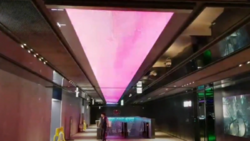Engineering:Ceiling led display
What Is Ceiling LED Screen?
A ceiling LED screen is a versatile display solution designed to be mounted overhead, offering dynamic visual content in various environments. Its integration into ceilings transforms spaces by providing informative or engaging content directly above viewers.
Types of Ceiling LED Screen
Flat Panel LED Screens: These are sleek and thin [displays] that can be seamlessly integrated into ceilings. They are ideal for applications where a clean, modern look is desired, such as retail stores, corporate offices, and hotel lobbies. An example is the Samsung SMART LED Signage IF Series.
Curved LED Screens: These displays offer flexibility in design, allowing them to be curved to fit the contours of the ceiling. They provide a captivating visual experience and are commonly used in theaters, auditoriums, and large event spaces. An example is the Absen Acclaim Series.
Transparent LED Screens: These screens allow light to pass through them, making them suitable for installations where natural light or visibility through the display is important. They are often used in retail environments, museums, and modern architectural spaces. An example is the Planar LookThru OLED Transparent Display.
Custom-Shaped LED Screens: These displays can be manufactured into various shapes and sizes to accommodate unique architectural designs or branding requirements. They are popular in creative installations in museums, galleries, and corporate headquarters. An example is the LG Transparent LED Film Display.
Techlogies Involved
== LED (Light Emitting Diode) Technology ==: LEDs are the tiny light sources that make up the display pixels. They provide bright, energy-efficient illumination and are durable for long-term use. Example: Samsung's Micro LED technology used in their Wall series displays.
Pixel Pitch: This refers to the distance between the centers of neighboring pixels. Smaller pixel pitch means higher resolution and closer viewing distances, while larger pixel pitch is suitable for farther viewing distances. Example: A 2mm pixel pitch display provides higher resolution than a 5mm pixel pitch display.
LED Module Design: LED modules are the building blocks of the display. They contain groups of LEDs and are designed to be easily assembled into larger screens. Example: Modular LED panels from companies like Absen or Leyard.
Display Control Systems: These systems manage the content displayed on LED screens. They include hardware and software for controlling brightness, color calibration, and input signals. Example: NovaStar LED controllers or Colorlight LED video processors.
Power and Heat Management: LEDs generate heat, so efficient cooling systems and power management are essential for maintaining performance and longevity. Example: Heat sinks and fans integrated into LED display designs.
These technologies work together to create vibrant, high-resolution visuals on ceiling LED displays, ensuring they deliver optimal performance and durability in various applications.

